What If? (15 page)
Authors: Randall Munroe

Lightning
Before we go any further, I want to emphasize something:
I am not an authority on lightning safety.
I am a guy who draws pictures on the Internet. I like it when things catch fire and explode, which means I do not have your best interests in mind.
Th
e authorities on lightning safety are the folks at the US National Weather Service:
http://www.lightningsafety.noaa.gov/
Okay. With that out of the way . . .
To answer the questions that follow, we need to get an idea of where lightning is likely to go.
Th
ere’s a cool trick for this, and I’ll give it away right here at the start: Roll an imaginary 60-meter sphere across the landscape and look at where it touches.
1
In this section, I answer a few different questions about lightning.
Th
ey say lightning
strikes the tallest thing around.
Th
at’s the kind of maddeningly inexact statement that immediately sparks all kinds of questions. How far is “around”? I mean, not all lightning hits Mount Everest. But does it find the tallest person in a crowd?
Th
e tallest person I know is probably Ryan North.
2
Should I try to hang around him for lightning safety reasons? What about other reasons? Maybe I should
stick to answering questions rather than asking them.
So how
does
lightning pick its targets?
Th
e strike starts with a branching bundle of charge
—
the “leader”
—
descending from the cloud. It spreads downward at speeds of tens to hundreds of kilometers per second, covering the few kilometers to the ground in a few dozen milliseconds.
Th
e leader carries comparatively little current
—
on
the order of 200 amps.
Th
at’s still enough to kill you, but it’s nothing compared to what happens next. Once the leader makes contact with the ground, the cloud and the ground equalize with a massive discharge of more like 20,000 amps.
Th
is is the blinding flash you see. It races back up the channel at a significant fraction of the speed of light, covering the distance in under a millisecond .
3
Th
e place on the ground where we see a bolt “strike” is the spot where the leader first made contact with the surface.
Th
e leader moves down through the air in little jumps. It’s ultimately making its way toward the (usually) positive charge in the ground. However, it “feels” charges within only a few tens of meters of its tip when it’s deciding where to jump next. If there’s something connected
to the ground within that distance, the bolt will jump to it. Otherwise, it jumps out in a semi-random direction and repeats the process.
Th
is is where the 60-meter sphere comes in. It’s a way to imagine what spots might be the first thing the leader senses
—
the places it might jump to in its next (final) step.
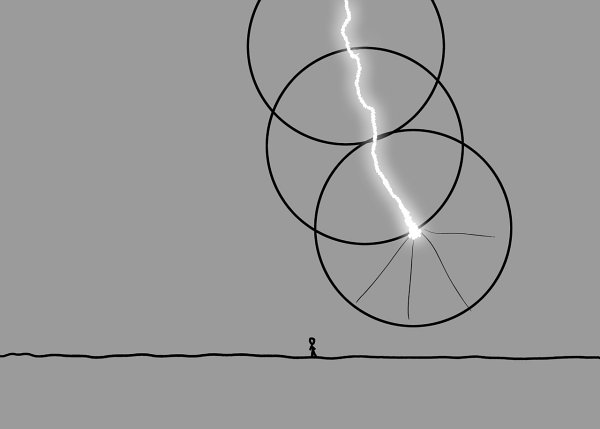
To figure out where lightning is likely to hit, you roll the imaginary 60-meter sphere across the landscape.
4
Th
is sphere climbs up over trees and buildings without passing through anything (or rolling it up). Places the surface makes contact
—
treetops, fence posts, and golfers in fields
—
are potential lightning targets.
Th
is means you can calculate a lightning “shadow” around
an object of height
h
on a flat surface.

Th
e shadow is the area where the leader is likely to hit the tall object instead of the ground around it:
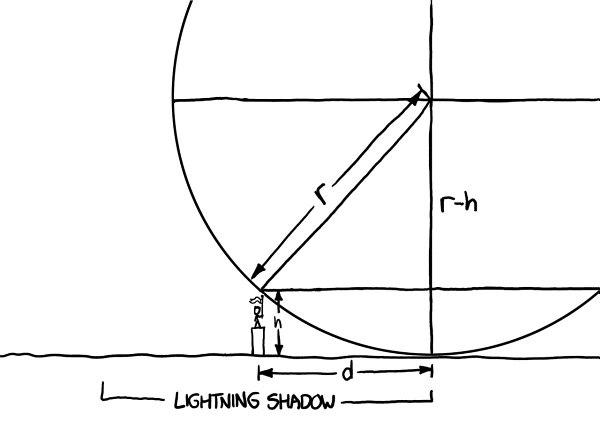
Now, that doesn’t mean you’re safe within the shadow
—
often, it means the opposite. After the current hits the tall object, it flows out into the ground. If you’re touching the ground nearby, it can travel through your body. Of the 28 people killed by lightning in the US in 2012, 13 were standing under or near trees.
With all this in mind, let’s look at possible lightning paths
for the scenarios in the following questions.
Q.
How dangerous is it, really, to be in a pool during a thunderstorm?
A.
Pretty dangerous. Water is
conductive, but that’s not the biggest problem—the biggest problem is that if you’re swimming, your head is poking up from a large flat surface. But lightning striking the water near you would still be bad.
Th
e 20,000 amps spread outward—mostly
over the surface—but how much of a jolt it will give you at what distance is hard to calculate.
My guess is that you’d be in significant danger anywhere within a minimum of a dozen meters
—
and farther in fresh water, because the current will be happier to take a shortcut through you.
What would happen if you were taking a shower when you were struck by lightning? Or standing under a waterfall?
You’re not in danger from the spray
—
it’s just a bunch of droplets of water in the air. It’s the tub under your feet, and the puddle of water in contact with the plumbing, that’s the real threat.
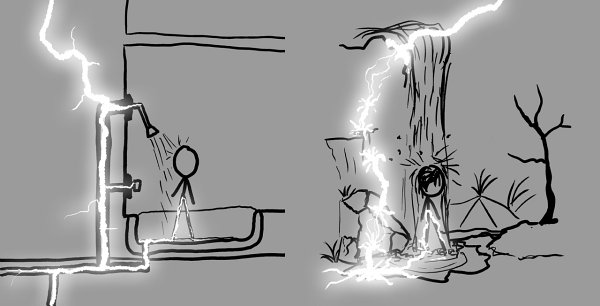
Q.
What would happen if you were in a boat or a plane that got hit by lightning? Or a submarine?
A.
A boat without a
cabin is about as safe as a golf course. A boat with a closed cabin and a lightning protection system is about as safe as a car. A submarine is about as safe as a submarine safe (a submarine safe is not to be confused with a safe in a submarine—a safe in a submarine
is substantially safer than a submarine safe).
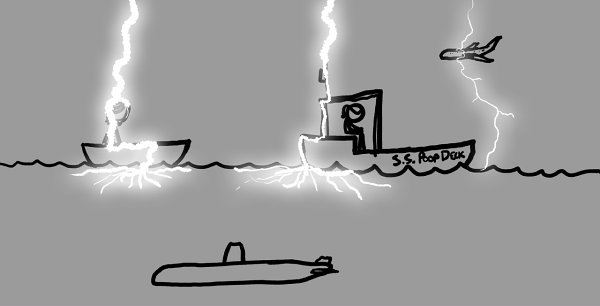
Q.
What if you were changing the light at the top of a radio tower, and lightning struck? Or what if you were doing a backflip? Or standing in a graphite field? Or looking straight up at the bolt?
A.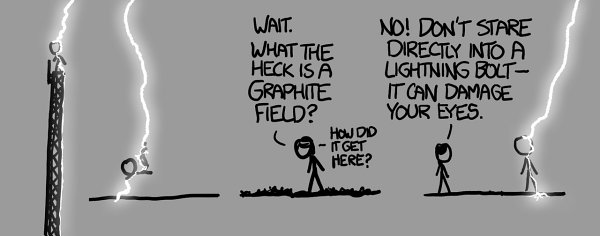
Q.
What would happen if lightning struck a bullet in midair?
A.
Th
e bullet won’t affect
the path the lightning takes. You’d have to somehow time the shot so the bullet was in the middle of the bolt when the return stroke happened.
Th
e core of a lightning bolt is a few centimeters in diameter. A bullet fired from an AK-
47
is about 26 mm long and moves at about 700 millimeters every
millisecond.
Th
e bullet has a copper coating over a lead core. Copper is a fantastically good conductor of electricity, and much of the 20,000 amps could easily take a shortcut through the bullet.
Surprisingly, the bullet would handle it pretty well. If it were sitting still, the current would quickly heat and melt the metal. But since it would be moving along so quickly, it would exit
the channel before it could be warmed by more than a few degrees. It would continue on to its target relatively unaffected.
Th
ere would be some curious electromagnetic forces created by the magnetic field around the bolt and the current flow through the bullet, but none of the ones I examined would change the overall picture very much.

